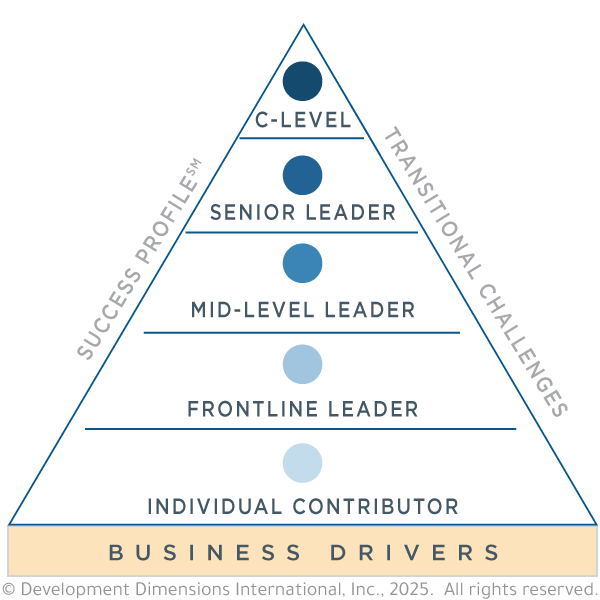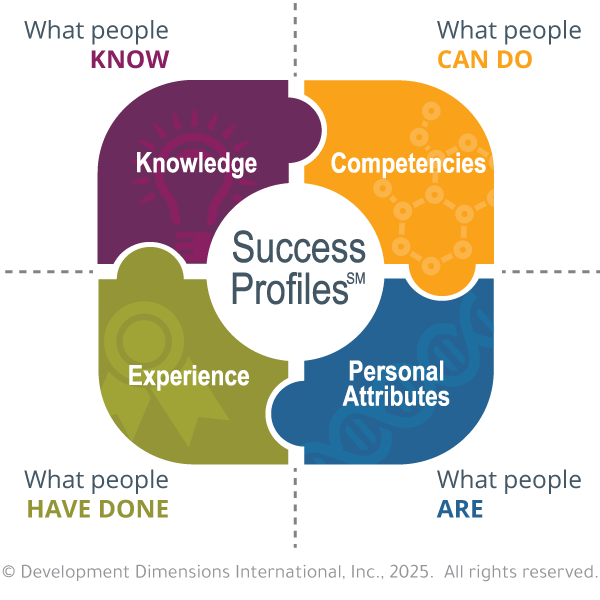Organizations face a critical challenge in today’s complex business environment: ensuring consistent, high-quality leadership at all levels. Without clear leadership standards, companies struggle to align leader expectations, develop talent effectively, and drive business success. A well-defined leadership competency framework provides the foundation for overcoming these challenges by establishing clear expectations for leaders and creating alignment across the organization.
A leadership competency framework defines the key behaviors and skills leaders need to succeed. It creates a common leadership language that aligns leaders at all levels, shaping company culture and reinforcing strategic business goals. The right framework ensures that leadership development is intentional, measurable, and impactful.
Ahead, we’ll explore the essential elements of a strong leadership competency framework and how it supports and integrates talent strategies, such as hiring, development, succession, and performance management. By understanding these key components, organizations can build a framework that drives measurable outcomes and ensures leaders are equipped to meet evolving business challenges.
What Is a Competency?
A leadership competency is a cluster of behaviors, skills, and attributes that define effective leadership performance. These competencies provide a structured way to assess, develop, and measure leadership effectiveness across the organization. Effective leadership competencies have several key characteristics. These competencies are:
Clearly Defined
A competency should specify the behaviors and skills required for success, rather than providing broad or vague definitions. Without clear definitions, leaders may struggle to understand what is expected of them. Well-defined competencies ensure leaders have a concrete understanding of what success looks like in practice.
Behavioral
Competencies should focus on specific actions and behaviors rather than abstract concepts. Defining behaviors makes it easier for leaders to apply competencies in real-world situations. A behavioral focus ensures that competencies translate into observable leadership actions rather than theoretical ideals.
Observable and Measurable
Effective competencies must be grounded in behaviors that can be seen, assessed, and improved. If competencies aren’t measurable, providing feedback or evaluating progress becomes difficult. Making competencies observable allows for objective assessment, targeted development, and meaningful performance conversations.
Integrated into Talent Strategies
Competencies should be used consistently across hiring, promotion, and development efforts. When embedded into talent processes, competencies provide a reliable foundation for making informed leadership growth and advancement decisions. Without this consistency, leaders may experience a disjointed journey—being hired based on one set of requirements, assessed on another, and promoted using different criteria—creating confusion and barriers to development.
Structured for Coaching and Feedback
A strong competency model enables leaders and teams to give structured, actionable feedback. Without a framework, feedback can be vague or subjective. By aligning feedback to competencies required for job performance and success, organizations create a culture of continuous development and accountability.
Appropriately Specific
Competencies should provide clear guidance, with core competencies applicable to all leaders and additional competencies tailored to specific roles and leadership levels. Overly broad competencies lack direction, while overly narrow ones limit adaptability. Key actions help bring competencies to life by defining specific, observable behaviors that drive leadership effectiveness.
A leadership competency framework defines the key behaviors and skills leaders need to succeed... The right framework ensures that leadership development is intentional, measurable, and impactful.
Why Key Actions Are Critical for Leadership Competencies
Leadership competencies provide a broad understanding of what great leadership looks like, but to truly develop leaders, we need more than just a definition—we need precision. That’s where key actions come in. Key actions break down a competency into specific, observable, and measurable behaviors that leaders can demonstrate in their daily work. This level of clarity makes leadership development more actionable and effective.
Let’s take a look at an example competency. Here are the key actions for Building Partnerships, where leaders develop and leverage relationships within and across workgroups to achieve results. To do so, leaders must:
Seek Opportunities to Build Relationships
Proactively engages with others who can support work goals.
Clarify the Shared Goal
Aligns expectations and identifies concerns to achieve mutual outcomes.
Develop Ideas Collaboratively
Contributes to and expands on the ideas of others.
Facilitate Agreement
Gains commitment from partners, confirming next steps and resource needs.
Support Partners
Prioritizes group success and offers resources for shared goals.
Involve Others
Seeks input to build alignment and engagement.
Maintain and Enhance Self-Esteem
Recognizes contributions and strengthens relationships.
Key actions bring leadership competencies to life by translating broad concepts into tangible behaviors. Leaders can build stronger relationships, drive collaboration, and achieve meaningful results by focusing on these specific actions. With this clarity, leadership development becomes more practical, measurable, and impactful—empowering leaders to grow confidently and consistently.
Differentiating Your Leadership Competency Framework by Level
A common question we hear from clients is whether they should differentiate their competency framework by leadership level. The answer? Yes—but only when it truly impacts how leaders apply the competency.

For example, both a frontline leader and a CEO need strong communication skills. However, the way they use these skills in their roles differs significantly. Defining these differences ensures that competencies remain relevant and actionable. Without this clarity, a “one size fits all” approach limits the framework’s effectiveness—whether for selection, succession, or development.
On the other hand, some organizations overcomplicate their frameworks by forcing unnecessary differentiation. Take Coaching and Developing Others as an example. While redefining this competency at the executive level versus the mid-level leader level may seem logical, the core behaviors may remain the same.
The key is intentional differentiation—aligning competencies with fundamental differences in responsibility and impact while avoiding artificial complexity. By striking this balance, organizations create a practical and powerful framework.
Making Your Leadership Competency Framework Operational

A well-designed leadership competency framework is one of the most powerful tools for driving leader effectiveness. However, to maximize its impact, organizations must integrate competencies into every stage of the talent lifecycle, including hiring, development, succession planning, and performance management. When competencies are actively used throughout these systems, they become the foundation for stronger leaders, better decisions, and sustained business growth. To see the greatest impact, organizations should take an integrated approach—embedding competencies across the full talent lifecycle rather than treating them as standalone elements.
When choosing where to start, consider:
- Which operational areas are most critical to the talent process and should be prioritized for competency integration?
- Where do you have momentum?
- Where do you have excitement and buy-in from stakeholders to embrace a competency model?
By first focusing on these key areas, organizations can build a strong foundation for embedding competencies across all talent systems, ensuring they drive real business value.
When to Update Your Leadership Competency Framework
Once you’ve got your leadership competency framework, how often do you need to update it? Leadership competencies should evolve as business strategy changes. Key triggers for updating a competency framework include mergers, digital transformation, strategic shifts in business goals or focus, and significant industry disruptions. Organizations that fail to realign their framework risk losing focus on the leadership behaviors that drive success.
If you don’t re-align your framework when the business strategy changes, you may find yourself without a “North Star” to guide your talent strategies. DDI’s competencies are built to align with business drivers, making it easy for organizations to adjust their framework as strategy evolves—ensuring leadership expectations remain clear and connected to business success.
Beyond Competencies: A Holistic View of Leadership Success
While competencies are foundational to leadership effectiveness, they are only one part of DDI’s Success ProfilesSM. By organizing competencies alongside the knowledge, experience, and personal attributes needed for each leadership job, organizations create a holistic picture of job success.

DDI’s Success Profiles include four key elements:
- Knowledge—The technical expertise required for the role.
- Experience—The critical background and practical exposure that prepare someone for the responsibilities of the job.
- Competencies—The observable behaviors and skills that drive success in the role.
- Personal Attributes—The inherent traits and characteristics that enable someone to thrive in the role.
From a development perspective, most of your focus may be on competencies. There are times, however, when you should incorporate experiences, knowledge, and personal attributes to create a more comprehensive development plan and holistic view of what drives a leader’s success.
For example, if a leader is preparing for a strategic leadership role, development shouldn’t be limited to formal training—it should also include critical experiences such as:
- Leading a cross-functional initiative to gain exposure to different areas of the business.
- Managing through a business transformation or restructuring.
- Presenting strategic recommendations to senior executives.
Similarly, if a frontline leader is preparing for a mid-level leadership role, relevant experiences might include:
- Leading a high-visibility project with increased scope and responsibility.
- Navigating a challenging coaching or performance conversation with a team member.
- Driving a process improvement initiative that impacts business outcomes.
Additionally, personal attributes—such as agility, resilience, and motivation—can shape how leaders approach development and adapt to new challenges. By integrating the Success Profile into development planning, organizations can ensure leaders gain the right mix of competencies, experiences, and personal growth opportunities to accelerate their readiness for future roles.
A well-defined leadership competency framework provides the foundation for overcoming challenges by establishing clear expectations for leaders and creating alignment across the organization.
Get Started with Your Leadership Competency Framework
We’ve shared a range of best practices for creating a solid, business-driven leadership competency framework—but the most important step is to put it into action.
Don’t overcomplicate the process or let your framework sit on the shelf. Instead, build a model that is clear, actionable, and aligned with your business strategy.
Remember:
- Focus on specific, observable behaviors that leaders need to demonstrate.
- Differentiate competencies by level only where they add real value.
- Identify key triggers for updating your framework so it evolves with your strategy.
- Make competencies a living part of your talent systems—from hiring to leadership development and performance management.
A great competency model isn’t just a document—it’s a strategic and practical framework tool for building stronger leaders and driving business success.
Have a Question?
FAQ
-
What is a leadership competency framework?
A leadership competency framework defines the key skills, behaviors, and attributes leaders need to succeed within an organization. At DDI, we use leadership frameworks to guide development, hiring, promotion, and succession planning strategies.
-
Why is a leadership competency framework important?
A leadership competency framework ensures organizations build leaders with the right capabilities to execute business strategy. At DDI, we help organizations align leadership development to future business needs by clearly defining the competencies that matter most.
-
How do you build a leadership competency framework?
Building a leadership competency framework involves identifying the skills and behaviors needed for success, validating them through business input, and integrating them into leadership development, assessment, and talent management practices. DDI partners with organizations to create customized, research-based frameworks.
-
How does DDI support building leadership competency frameworks?
DDI offers success profile consulting services that help organizations build leadership competency frameworks aligned to their unique business strategies. Our frameworks are backed by decades of leadership research and tailored to drive measurable impact.
Topics covered in this blog

